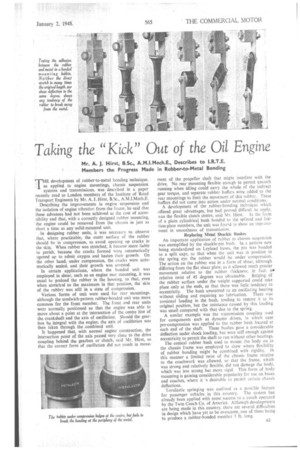Taking the "Kick" Out of the Oil Engine
Page 35

If you've noticed an error in this article please click here to report it so we can fix it.
Mr. A. J. Hirst, B.Sc., A.M.1.Mech.E., Describes to 1.R.T.E. Members the Progress Made in Rubber-to-Metal Bonding
THE development of rubber-to-metal bonding technique, as applied to engine mountings, chassis suspension systems and transmissions, was described in a paper recently read to London members of the Institute of Road Transport Engineers by Mr. A. J. Hirst, I3.Sc., A.M.I.Mech.E.
Describing the improvements in engine suspension and the isolation of engine vibration from the frame, he said that these advances had not been achieved at the cost of accessibility and that, with a correctly designed rubber mounting, the engine could be removed from the chassis in just as short a time as any solid-mounted unit.
. In designing rubber units, it was necessary to observe that, where practicable, the outer surface of the rubber should be in compression, to avoid opening up cracks in the skin. When rubber was stretched, it became more liable to perish, because the cracks formed were automatically opened up to admit oxygen and hasten their growth. On the other hand, under compression, the cracks were automatically sealed, and their growth was arrested.
In certain applications, where the bonded unit was employed in shear, such as an engine rear mounting, it was usual to preload the rubber in the housing, so that, even when stretched to the maximum in that position, the 'skin of the rubber was still in a state of compression.
Various 'forms of unit were used for rear mountings, although the sandwich-pattern rubber-bonded unit was more common for the front member. The front and rear units were normally positioned so that the engine was able to move about a point at the intersection of the centre line of the crankshaft and the axis of oscillation. Should the gearbox be integral with the engine, the axis of oscillation was then taken through the combined unit.
It happened that, with normal engine construction, the intersection point of the axis passed very close to the drive coupling behind the gearbox or clutch, said Mr. Hirst, so that the correct form of oscillation did not result in move ment of the propeller shaft that might interfere with the drive. No rear mounting flexible enough to permit smooth running when idling could carry the whole of the indirect gear torque, and separate rubber buffers were added to the rear mountings to limit the movement of this rubber. These buffers did not come into action under normal conditions.
A development of the rubber-bonding technique which offered great advantages, but had proved difficult to apply, was the flexible clutch Centre, said Mr. Hirst. lii the form of a plain cylindrical bush bonded to the splined and friction-plate members, the unit was found to show an improvement in smoothness of transmission.
Replacing Metal Shackle Bushes
An important application of rubber to chassis suspension was exemplified by the shackle-pin bush. In a pattern now being standardind on Leyland buses, the pin was bonded to a split cage, so that when the unit was in position in the spring eye the rubber would be under compression. The action on the rubber was in a form of shear, although differing from the flat shear plate, as it allowed much greater movement relative to the rubber thickness; in fact, a* relative twist of 45 degrees was obtainable. Bulging of the rubber surface under, the weight supported could take place only at the ends, so that there was little tendency to eccentricity. The bush amounted to an oscillating bearing without sliding and requiring no lubrication. There was torsional loading in the bush, tending to restore it to its original position, but the resistance caused by this loading was small compared with that due to the spring.
A similar example was the transmission coupling used for components such as dynamo drives, in which case pre-compression was applied to the rubber bush located at each end of the shaft. These bushes gave a considerable deflection under shock loading, but were stiff enough against eccentricity to permit the shaft to run without other bearings.
The conical rubber bush used to mount the body on to the chassis frame was employed to show where flexibility of rubber bonding might be combined with rigidity. In this manner a limited twist of the chassis frame relative to the coachwork was allowed, so that the frame, which was strong and relatively flexible, did not damage the body, which was less strong but more rigid. This form of body mounting is gaining considerable popularity for use on buses and coaches, where it ss desirable to permit certain chassis deflections.
Torsilastic springing was outlined as a possible feature for passenger vehicles in this country. The system has already been applied with some success to a coach operated by the Twin Coach Co. of America. Although developments are being made in this country, there are several difficulties in design which have yet to be overcome, one of them being to produce a rubber-bonded member 5 ft. long.












































































